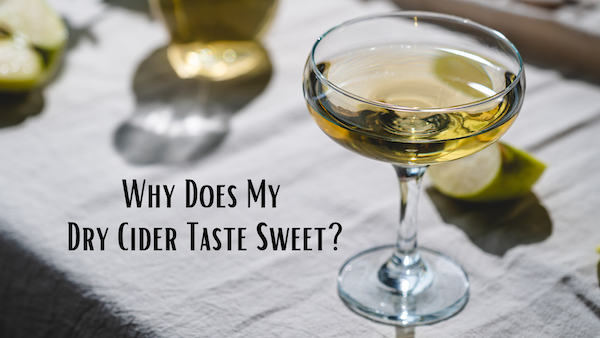Why Does My Dry Cider Taste Sweet?

Written by Tim Godfrey
Cider has long dealt with assumptions and misrepresentations of sweetness. In fact, the first reaction when folks are asked about cider often relates to the question of how sweet it is. Curiously, this happens in cases where the cider is actually quite dry, but is adamantly proclaimed as sweet. Why is this?
In the realm of tasting and sensory evaluation, the distinction between perceptive sweetness and residual sugar presents a captivating conundrum for Pommeliers, industry professionals, and even the average drinker. These terms, though seemingly interchangeable, unveil distinct concepts that significantly influence our sensory experience. Perceptive sweetness encompasses the remarkable interplay of our taste buds and olfactory receptors, enabling us to perceive sweetness in a cider despite the absence or minimal presence of residual sugar. It is an intriguing phenomenon that relies on the intricate complexities of sensory perception. Our brain’s ability to deceive us becomes apparent as taste and aroma interact, conjuring a perceptual illusion of sweetness, even in ciders with restrained residual sugar content. This phenomenon is typically attributed to three other sensory characteristics of cider: Aromatics, Acidity, and Alcohol.
Aromatics
Ciders contain a vast array of aromatic compounds derived from various sources, including the apples themselves, fermentation, and aging processes. Fruity aromas, such as those reminiscent of ripe apples, citrus or tropical fruits, or any added fruit to the cider can evoke associations with sweetness, that we generally term “fruitiness”. Even in the absence of substantial (or any) residual sugar, the presence of fruity aromas can trick our senses into perceiving a cider as sweeter than it actually is. The same is true of ciders aged in oak barrels, which can contribute flavors such as vanilla, caramel, or spices. These additional aromas interact with the fruit character and create a sense of sweetness on the palate even when no sugar is present. This is likely due to the close link between the olfactory receptors in our noses that perceive these fruity aromas, and the taste buds on our tongues that perceive sweetness. Knowing how something will taste based on how it smells is anatomically connected as well. The olfactory receptors perceive aromas through two pathways: directly through the nose – “orthonasal”, and through the back of our throat – “retronasal”. This is all to say that our sense memories of fruit as “sweet” is complicated by the anatomy of aroma perception, creating perceptive sweetness when sugar might not actually be present.
Acidity
Our taste buds perceive five basic tastes, all of which interact and counteract each other in differing, complex ways. Acidity and Sweetness are two of these that tend to have a counteracting relationship and are foundational in our perception of cider. Acid tends to provide a light, refreshing quality to cider, whereas sweetness contributes viscosity and body. Balance is achieved when these two sensations are in harmony, but given their counteractive nature, the interaction between sweetness and acidity can influence our perception of residual sweetness. For example, high acidity tends to mask or diminish the perception of sweetness, resulting in a lighter, crisp body, whereas ciders with low acidity and high residual sugar can result in a cloying, syrupy sweetness, and “flabby” body. An overly sweet cider can be “fixed” with the addition of acid and vice versa, but this can be hard to discriminate as a taster. In cases where it is unclear whether or not real sugar is present, rely on your tongue to feel the texture of the cider rather than the taste.
Alcohol
Frankly, at the regular ABV of most ciders (5-8%) alcohol does not seem to bring the same perceptive sweetness impact as it does in wine. However, it is well known that the presence of alcohol in wine can amplify the perception of sweetness, and that premise could still apply to cider to a degree. Alcohol stimulates our sweet taste receptors, intensifying our perception of sweetness even in the absence of substantial residual sugar. This interaction between alcohol and our taste buds creates an intriguing sensory experience that can deceive our palate. Alcohol also contributes to the overall balance and integration of flavors in cider. It adds body, texture, and warmth to the cider, complementing other sensory elements. When combined with residual sugar, alcohol can create a perception of sweetness that is greater than the actual sugar content would suggest. Alcohol’s impact on body and texture also influences the mouthfeel and viscosity of cider. Higher alcohol levels impart a fuller, more viscous texture, which is similarly experienced in sweet ciders. So while the impact of alcohol on perceptive sweetness may not be as exaggerated in cider as it is in wine, it undoubtedly still plays a role.
How do we overcome the mind games of perceptible sweetness versus residual sugar in cider? Consider these five tips when assessing a cider:
- Analyze the Label: Look for terms such as “dry” or “off-dry,” which indicate lower residual sugar levels. Style can also impact residual sweetness. If the cider was carbonated using a secondary fermentation, chances are it is dry. In some cases you might be able to consult the Nutrition Facts label, so take a look to see if the cider has added sugar.
- Assess Acidity: Evaluate the cider’s acidity level. Higher acidity levels can counterbalance residual sugar, resulting in a drier taste perception. Ciders with a pronounced acidic backbone are more likely to exhibit perceptive sweetness rather than substantial residual sugar.
- Evaluate Mouthfeel: Pay attention to the cider’s texture and viscosity. Ciders with a thicker or syrupy mouthfeel often correlate with higher residual sugar levels. On the other hand, ciders with a lighter and more refreshing mouthfeel are more likely to convey perceptive sweetness without significant residual sugar.
- Consider Alcohol Content: Take note of the alcohol level in the cider as indicated on the label. Higher alcohol concentrations can enhance the perception of sweetness. Even in the absence of residual sugar, ciders with elevated alcohol content may impart a perceived sweetness due to the stimulation of sweet taste receptors.
- Trust Your Palate: Ultimately, building a discerning palate takes time and experience tasting ciders. Keep on tasting! Looking for dry ciders to try? Check our our Dry Cider Directory!

Tim Godfrey has been involved in the cider industry for over ten years, making cider commercially in the Midwest as well as on the West Coast, and has volunteered for the American Cider Association since 2019. Tim currently works at Lake Michigan College in Benton Harbor, MI in the Wine and Viticulture Program, running the teaching winery and instructing enology coursework. He continues to stay involved in the cider industry through the ACA, as a consultant to startup and emerging cideries across the U.S. through his business Godfrey Beverage Solutions, and as a home orchardist and cidermaker. He is also a Certified Pommelier™.
